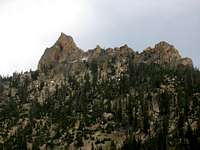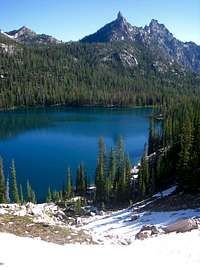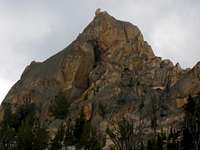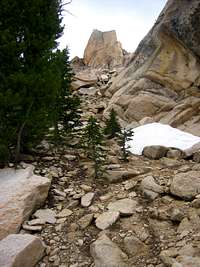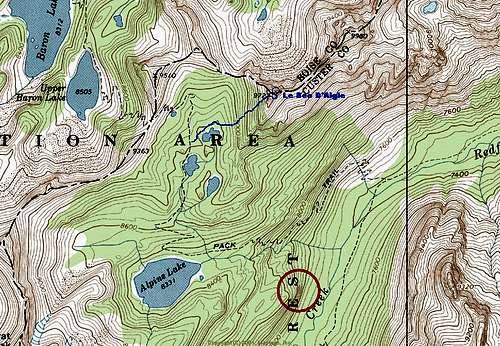-
 14404 Hits
14404 Hits
-
 81.76% Score
81.76% Score
-
 14 Votes
14 Votes
|
|
Mountain/Rock |
|---|---|
|
|
44.07683°N / 115.01192°W |
|
|
Boise |
|
|
Hiking, Trad Climbing, Scrambling |
|
|
Summer, Fall |
|
|
9727 ft / 2965 m |
|
|
Overview
With perhaps as few as 10 ascents ever, Le Bec D'Aigle or the Eagle's Beak, provides some high quality and easy rock climbing on solid and exposed terrain. This prominent spire looks very much like a downward pointing bird's beak if view from the west or northwest. The beak is actually a downward sloping, detached boulder at the summit that requires a 5.4 move to get over it. With nearby Alpine Lake, perhaps the most popular backpack destination in the Sawtooths, it's surprising that the peak hasn't seen more climbers. As of this writing in July of 2006, the last ascent before this one was in 1991. The summit register, the slings, and the type of nut left behind all indicate that this is accurate.
Le Bec D'Aigle is the westernmost point on a ridge that starts with Mt. Heyburn in the east and has many technical spires jutting up along this spectacular line. The likes of the West Pinnacle, the Split Tooth, The Splintered Tower, The Rotten Monolith, and Flatrock Needle or the Red Sentinel, to name a few all have obscure quality climbs. Almost surprisingly, the rock quality on the SE Face side is very solid. While the actual climbing is rated quite easy, the exposure makes up for this. A good combination of ledges, ramps, and chimneys lead to a crack system below the summit. The last few moves are on an exposed and airy face. From the tiny and narrow summit, the views are spectacular and include the impressive Packrat Peak along with Elk Peak, and Baron Spire to name a few of the more impressive peaks.
Routes
Southeast Face
This exciting routes involves exposed, but easy climbing on solid rock. See the Routes Page for more.
North Buttress
This full 120 foot pitch was first climbed by Lyman Dye, M. Howard, and the Mazamas. The rating is 5.5, but varies slightly depending on the exact line. This climb can be approached via the SE Face approach, or from the Braxon Lakes / Alpine Lake saddle. The buttress starts off solid, but has some rotten and exposed sections near the top
Activity Matrix
| Activity | Rating | Required Experience |
| Rock Climbing | 9 | intermediate |
| Alpine Climbing | 5 | intermediate |
| Hiking / Scrambling | 8 | intermediate |
| Trail Running | 7 | intermediate |
| Mtn Biking | 0 | n/a |
Key:
p=potential, but unknown
Getting There
The primary approach for the Eagles' Beak is from the Redfish Lake area. Utilizing the summer shuttle boat saves 4.7 miles. From the Redfish Transfer Camp follow the trail along Redfish Creek for 3.7 miles to the Alpine Lake / Baron Pass junction. Take the junction as it climbs up to the Alpine Lake Basin at 5.4 miles with an altitude of 8400 feet near the lake. Continue past Alpine Lake and at 6.3 miles near the northernmost unnamed lake, leave the trail and scramble up the NW side of the Eagles' Beak. Find a weakness in the southwest ridge and cross from the NW side to the SE side of the spire. The route becomes clearer at this point. Continue around to the north side for that route.
The total mileage (one-way) is 6.8 miles with an elevation gain of 3698 feet. Add 4.7 miles if not using the shuttle boat.
If approaching from the Grandjean Area, follow the Baron Creek Trail past Baron Falls, Baron Peak, Baron Spire, and Baron Lakes and over Baron Pass. While this approach is much longer is very scenic
The total mileage (one-way) is 12.5 miles with an elevation gain of 6188 feet


